Dugan and Diamond Beaded Basket
By Dr. Larry Keig
The Dugan and Diamond glass factories were the principal producers of carnival baskets. A good many of them had applied glass handles. The handles of others were molded. Some of the baskets were reconfigured from pre-existing patterns, others uniquely designed. Some were artfully conceived. Others appear to have been hastily created, presumably to fill production, marketing, and sales needs, profit motive winning out over aesthetic appeal. They range from tiny to generous in size.
Other baskets were created when a bowl was fitted into a metal frame. These frames were produced by firms which specialized in making that sort of thing, almost certainly before the glass was crafted so that the bowl could be shaped to fit tightly into the holder. Probably niche items, they eventually began to be referred to as “brides’ baskets,” whether or not they were intended to be used at weddings.
Compared to other baskets made by Dugan and Diamond, the Beaded Basket is the most realistic in design. It actually looks like one of those iconic wicker laundry baskets of old. It is also impressive because its pattern elements are proportionately raised above the surface of the container.
The principal elements, which occupy most of the exterior, are three bands of basketry. The center band has a horizontal weave. The bands above and below that have diagonal weaving. Atop the rows of basketweave is a band of inverted parabolas which extend to a scalloped top edge. Two molded handles, one across from the other, are attached to these upside-down arches. The interior and underside of the collar base are unpatterned.
Handles of Dugan and Diamond Beaded Baskets are configured in two different ways. Some have straight- up handles. The handles of others are flared. These handle variations appear to coincide with which owner was operating the plant at the time the basket was produced, to which see below.
The tops of these baskets are shaped in two ways. Many are round. Others are oblong. Some of the oblong are more drawn out than others. Top shape does not appear to be related to which firm produced them.
The Matter of Manufacturer
The maker of the Beaded Basket has been ascribed, until recently, to Dugan. Yet no available advertising in wholesale glass catalogs of the time appeared until 1914 and 1915, shortly after ownership of the plant changed hands and it became the Diamond Glass (or Glassware) Company.
Now the question has become: Which firm (Dugan or Diamond) manufactured the Beaded Basket? It seems likely, based on colors and the handle shapes in which the baskets were made that both firms produced them.
It’s important to point out that some of the advertising materials from the time may not yet have surfaced or may have been lost. It is also possible that not all items made by these companies ever appeared in Butler Brothers or other wholesale catalogs. Retailers may have instead seen new products for the first time at events, largely on the East Coast, where manufacturers displayed their wares and took orders. These suppositions may explain why there has been confusion as to which of the two manufacturers made Beaded Baskets.
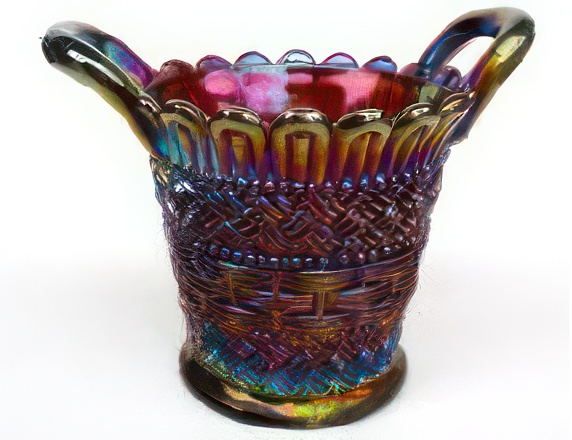
This Dugan oxblood/fiery amethyst has especially fine iridescence. This color is the most often seen Beaded Basket in the shape with flared handles. Photo courtesy of Rick and Debbie.
Colors of Dugan Beaded Baskets
Based on available base and surface colors and handle configurations, it is highly probable (or almost certain) that three colors were made by Dugan in abundance and another in far shorter supply. The common colors are oxblood and fiery amethyst, amethyst, and white. The other, hardly ever seen, is marigold. All four have flared handles.
Oxblood and Fiery Amethyst. Often called black amethyst oxblood and fiery amethyst are barely translucent, deeply intense colors. When held toward a bright light source, the oxblood is a deep rich purple, the fiery amethyst a lush reddish-plum. Combined, these black amethyst shades are seen more often than other Dugan flared-handled Beaded Baskets. At the time of manufacture, this color is what Dugan called “African Iridescent.”
Amethyst. The Dugan amethyst are definitely amethyst in color, not what most collectors consider purple. This distinction makes it clear that the firm definitely intended to produce both dark and light shades on the lavender to black amethyst spectrum. The amethyst Beaded Basket with flared handles is harder to track down than the oxblood and fiery amethyst. No bona fide purple Beaded Basket has been confirmed.
White. The white are the second in line to the black amethyst in terms of sheer numbers. Some of these are frosty, others nearly clear iridized glass. In general, the frostier they are, the more desirable. Tops of flared-handled white baskets are often more elongated than are the other colors.
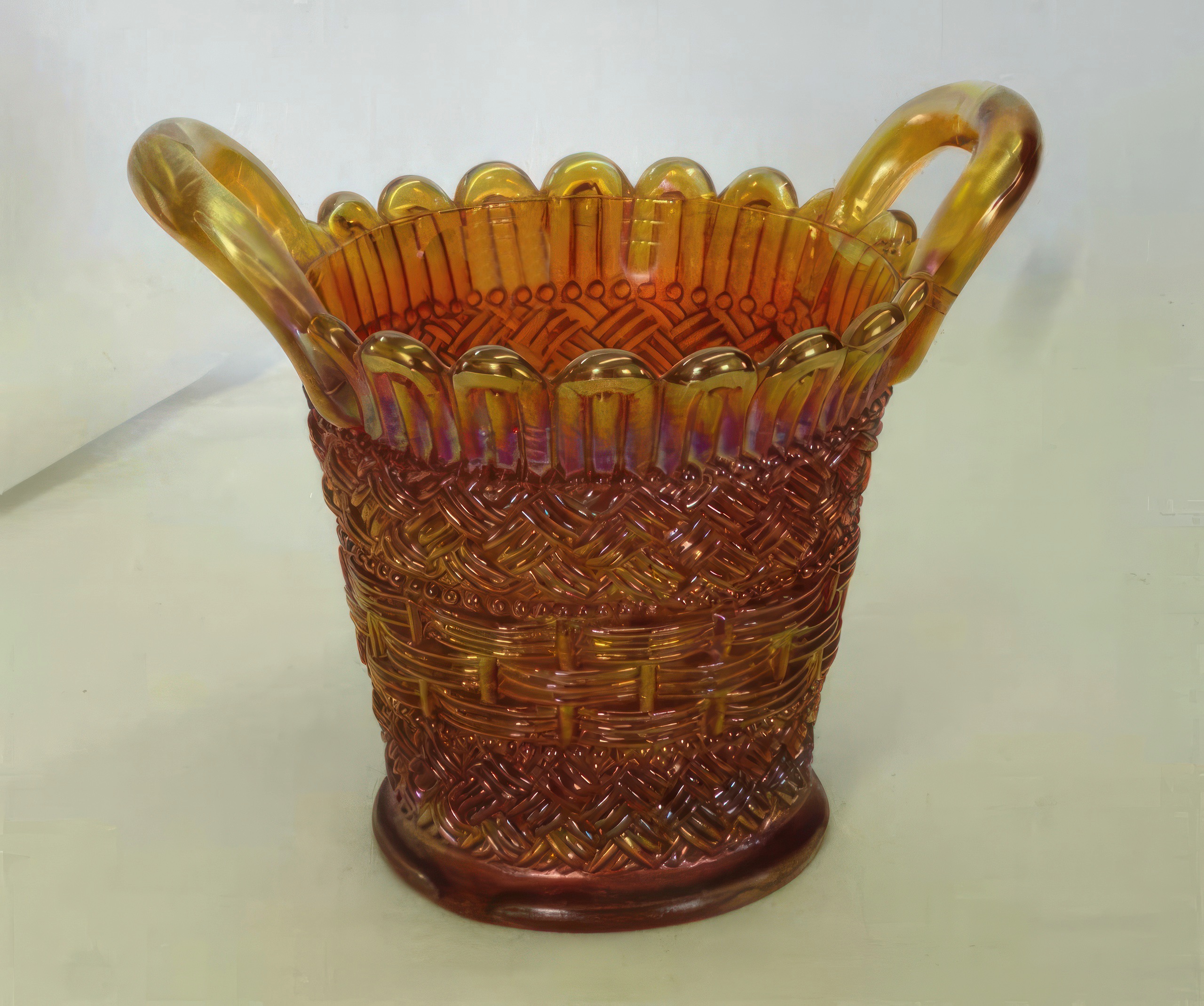
The marigold Beaded Basket with flared handles is rare. Very few have sold at carnival glass auctions, on site or online.
Marigold. Dugan’s marigold is, to many collectors’ surprise, a scarce color and the marigold Beaded Basket with flared handles is rare. Only one has been recorded as having sold in the HoC database and two others are known. All three have a vibrant surface color and multi- color iridescence setting them apart from most of their Diamond counterparts.
No Beaded Basket is known in peach opalescent, Dugan’s signature color. It seems improbable that any were made, given that none has been reported as having sold since price guides and computer databases have been available.
The Beaded Basket with flared handles has been reproduced. These have been confirmed in dark green and white and may also have been made in other colors. The two colors that are known are marked on the flat interior surface. It’s possible the marks have somehow been removed so it is important to look carefully for baskets which may have been defaced.
Colors of Diamond Beaded Baskets
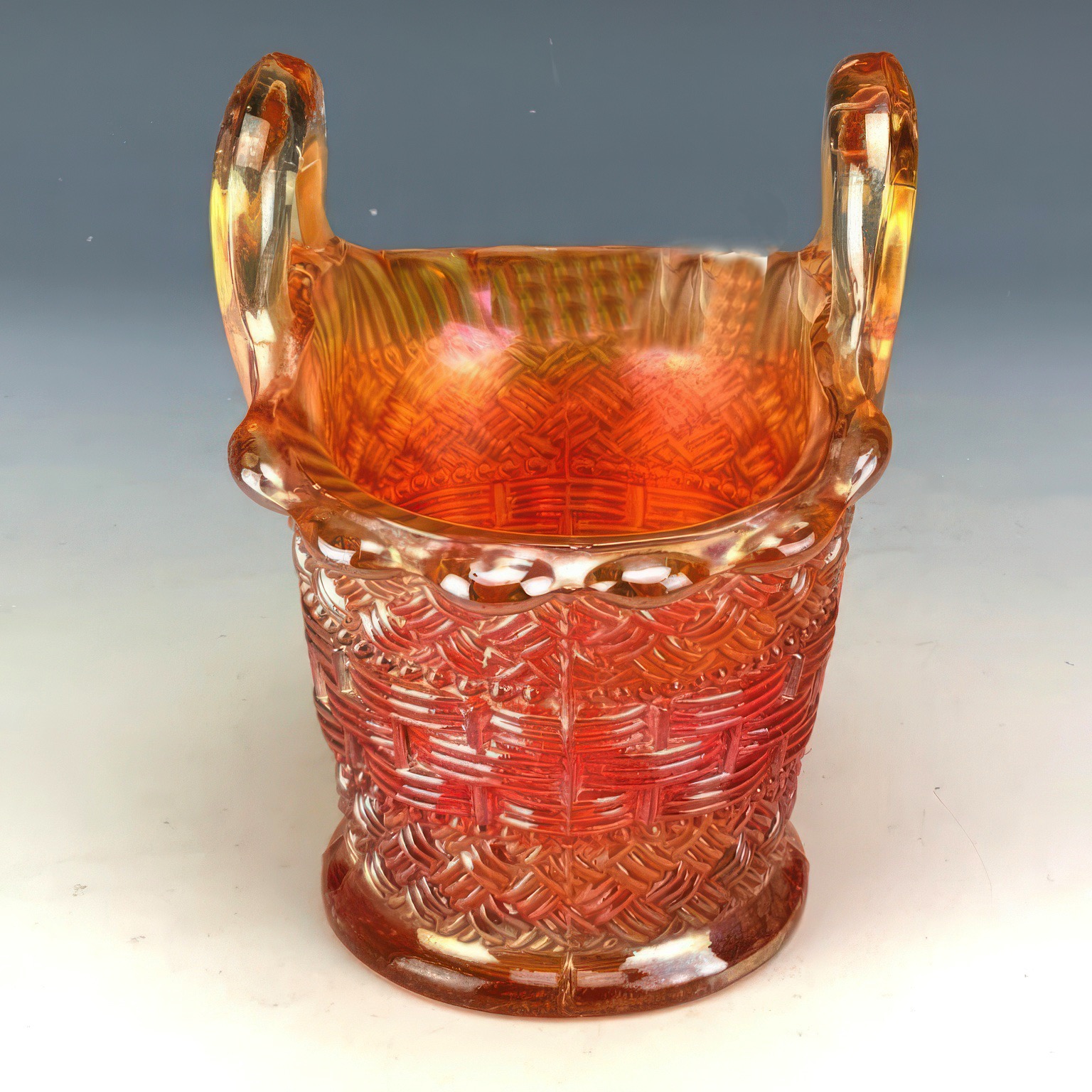
Marigold. Whereas Dugan’s flared handled Beaded Basket was made in limited quantities, Diamond’s was made in massive numbers. the marigold Beaded Basket with straight-up handles is Diamond’s most common color and marigold the most quotidian in all Diamond patterns. While there are exceptions, most are light in color and have little in the way of iridescence other than the marigold overlay.
Amethyst. The base color of Diamond’s Beaded Basket with straight-up handles range in color from strong to a very light hue. Those that are light are sometimes described as lavender but should not be unless the iridescence is pastel. The base color of most is similar to that of their Dugan counterpart. No basket post-1913 has been authenticated in oxblood or fiery amethyst. Diamond baskets in amethyst are harder to come by than the corresponding Dugan.
Blue. Indiana, Pennsylvania, blue carnival may have been introduced at the end of the Dugan era but is associated primarily with Diamond’s “water set era” (1913 to 1916 or ’17). It is an intense dark color, a shade that many collectors of today call cobalt. The iridescence on the Diamond blue Beaded Baskets is highly variable, ranging from bright to dull, multicolor to silvery. Horrifying as it may seem, Diamond actually marketed carnival with a silver cast, describing it in wholesale catalogs as “gun metal” or “steel.” A cynic might say that promoting and merchandizing unattractive glass like this was a ploy to unload it on an undiscriminating public without having to dispose of it at the factory dumpsite. (It’s possible blue Beaded Baskets with flared handles were also produced.)
Aqua and/or Sapphire. Confusion reigns when it comes to determining whether the base color of this basket is aqua or sapphire. When looking through the base in attempting to identify color, it is clearly aqua. But when looking through the narrowest area above the base, it is, without question, a Windex blue which, in carnival terminology, is sapphire. So, who knows what it should be called. Regardless, the exterior is covered with heavy butterscotch iridescence. None has been reported without the overlay.
Pink with Marigold Overlay. The pink Beaded Basket with marigold overlay is Diamond’s iridized version of its uniridized Afterglow pink. It was a late entry in the carnival world, introduced in the mid-1920s. These vary in the amount of overlay. Those with relatively little are more desirable than those that are fully covered. It’s easier to find a non- iridized Afterglow pink than the iridized. No pink with overlay Beaded Basket has been reported as having sold in the HoC database but the color definitely exists.
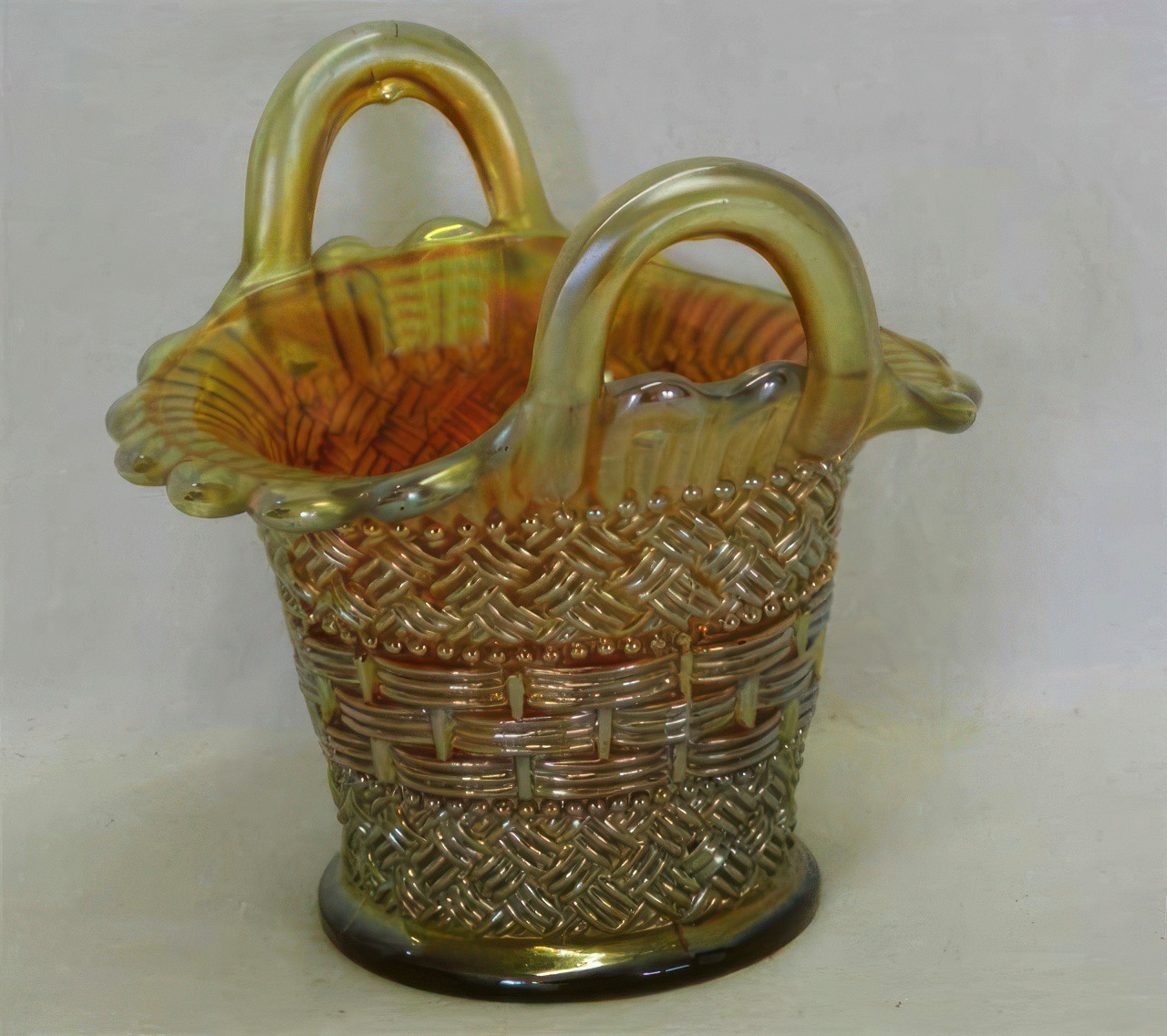
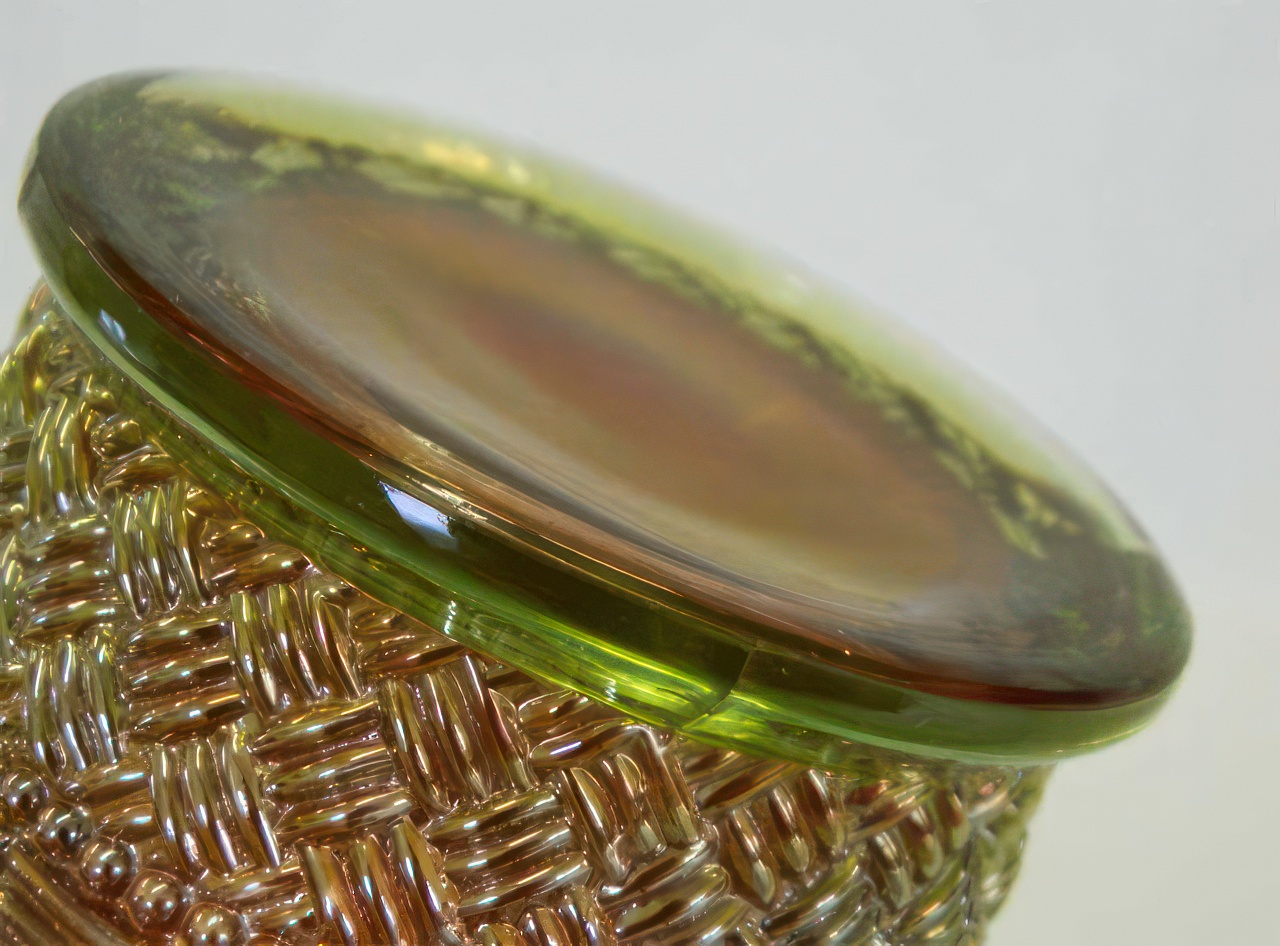
Diamond’s lime green with overlay was made late in the Diamond era. It is the iridized version of the firm’s uniridized pastel green Afterglow.
Lime Green with Marigold Overlay. The lime green Beaded Basket is the pink’s counterpart. The base color is more pastel than lime, considerably lighter than the rind of the citrus fruit. Like the pink, the green was introduced in the mid-1920s in a non- iridized Afterglow but soon made available with the marigold overlay. One is recorded in the HoC database.* Neither the pink nor the lime is much in demand.
White. It is not clear if Diamond ever made a white Beaded Basket with straight-up handles.** While some of the white shown on the HoC database look like they might have straight-up handles, it is not possible to make that determination with certainty, given how the basket was positioned for the picture-taking. It would not be surprising to learn they are non- existent as white is generally thought of as Dugan, not Diamond, at least not until the color was reintroduced in the 1920s when it reappeared in stretch glass. The stretch are represented by a limited number of carnival patterns. These include hard-to-find Coin Dot compotes and Standard vases.
Beaded Baskets are also said to be available in vaseline. One was reported, in the 1991 Mordini price guide, as having sold. If it was vaseline, it likely has a marigold overlay. A vaseline without overlay would have brought good money, even back then It’s possible that it was misidentified, that it was actually lime green.
The Beaded Basket Whimsey
The whimsey is a Beaded Basket without the handles. While the glass was still malleable, the handles were lopped off. Then, shortly thereafter, the areas where the handles had been were iridized over.
The piece is a medium marigold with little in the way of iridescence other than the surface color overlay. These observations suggest an early Diamond origin but that’s conjectural. Regardless, it’s an interesting piece for which there are probably no duplicates.
Notes
*If anyone owns a lime green he or she wants to sell, please let me know. It’s the only verified color I don’t have.
**Readers who can confirm white Beaded Baskets with straight up handles are asked to report them.
Photos courtesy of HOC, the Auctioneers who provided them, and the Grahams.
This article first appeared in the ICGA Pump in the June 2024 issue and is reprinted with permission.
